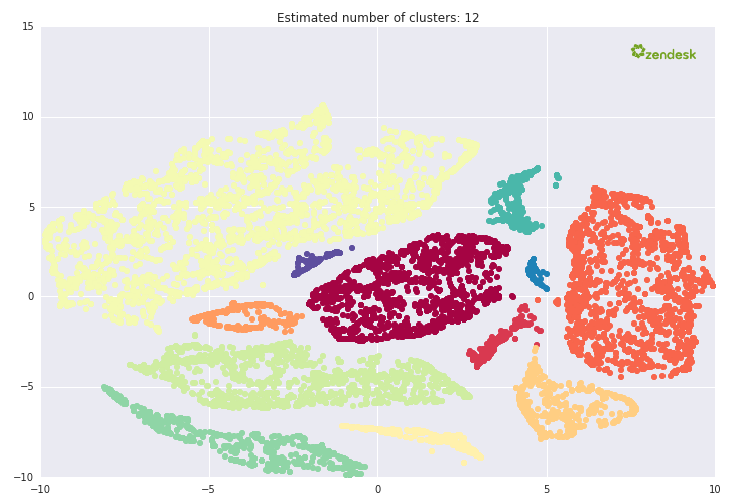“Actions speak louder than words,” right? How you behave means more than what you say or what you look like. Turns out, this applies not just to people, but to sales, marketing, social media, and especially customer service management. When thinking about the latter, it can be helpful to look beyond typical industry designations (what your company “looks” or “sounds” like) in order to find a more relevant and accurate classification for benchmarking customer service performance.
Why is that important? Simply put, businesses need to understand what kind of customer service organization they have in place—and with that knowledge comes opportunities to rethink how companies can pivot toward providing a better customer experience. Over the years, Zendesk has conducted in-depth studies that have revealed important data about these classifications, as well as operational benchmarks set by customer service leaders. Gaining a thorough understanding of what type of support organization your business runs and what good customer service looks like isn’t just a “nice to have”—it’s a necessity in the modern marketplace.
The true value of customer support
The four types of customer service organizations
Relationship builders
Masters of complexity
Late bloomers
Captains of scale
Using a cluster analysis process, we grouped customer service organizations based on similar operational and management traits and found that support teams fall into four main types that can serve as an alternative to more superficial industry benchmarking.
1. Relationship builders
These small teams excel in relationship management and provide a personal customer experience that customers love. The culture could be seen as an extension of their marketing.
2. Masters of complexity
Driven by detailed support requests, these companies have dynamic management structures and sophisticated customer service operations.
3. Late bloomers
With an unbalanced approach to support management, these companies have yet to realize their full potential. They might be too focused on their sales or marketing departments (a common problem with start-ups) instead of supporting their users.
4. Captains of scale
These teams value customer service management as much as they do for sales and marketing, and set the gold standard of customer support operations.
How we got there

To conduct the analysis, the research grouped businesses and organizations together in 12 clusters based on metrics that revealed similar workloads, support strategies, and the resource availability of their customer service operations. Those 12 were refined further into four groups with similar operational traits and management maturity.
This focus on operational benchmarking was more than just a fun data exploration—the report dives into each of the four types (and the 12 clusters within them) to provide insight and tips, as well as actual benchmarks for comparing organizations on a much more meaningful and relevant basis. Industry benchmarks—as well as company size and audience type—are still a big deal for many companies looking for comparison overviews. But as we discovered, many companies will better relate to companies that have similar operations and management, regardless of industry.
With these four types of customer service organizations in mind, let’s turn to Zendesk’s latest research, which sheds light on many trends in customer support. Based on data culled from 45,000 companies in a wide range of industries, the 2019 Benchmark report provides insights about how support leaders elevate their game—which in turn, becomes the new standards that other businesses have to meet.
And depending on where your company falls in the four types of service organizations, those expectations can be eminently achievable or a serious challenge. Here are a few takeaways:
1. Customers’ expectations keep rising. And CSAT scores keep dropping
It’s no coincidence that nearly half of customers surveyed reported their service expectations having grown in just the past year alone. That tracks with average CSAT scores, which have declined from 94.6% in 2013 to 92.5% in 2018—so in other words, it’s getting tougher to meet the requirements of the market. If your company has scaled support operations wisely to keep up with growth, or if you focus on relationship-building (which can create loyal customers), you might be able to keep pace with the demands of your customer base. But if your business falls into the “late bloomer” category, you will likely struggle to provide the kind of experience customers want. It could be time to think about dedicating the kind of resources to support that you have for sales and marketing.
2. Customers want self-service options, but companies are lagging behind
40% of customers check search engines or a help center before reaching out to a customer service representative, yet just a fifth of businesses offer people the self-service experience they desire. For “relationship builders,” the size of the team can make it difficult to create up-to-date, comprehensive self-service content. And for late bloomers, they might not even understand that self-service options are desperately needed. But the truth is that the price of not investing in self-service is steep.
3. Omnichannel makes all the difference
Here’s a sobering statistic: 69% of customers want businesses to respect their time by not making them repeat their complaints over and over, an irritation that becomes more pronounced as those same customers switch from channel to channel. Captains of scale understand that very clearly, as do masters of complexity–and their inclination to spend time and resources on enabling support teams to give customers a seamless omnichannel experience have paid off. And remember: those other customers not clamoring for omnichannel will likely change their tune as they deal with more and more businesses that put that experience front and center.
